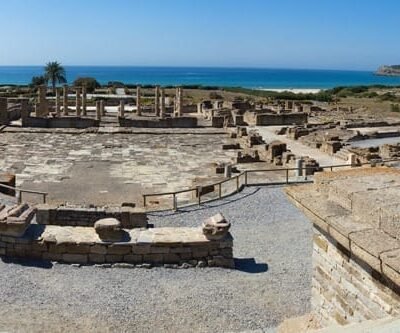Valverde de los Arroyos: The Charming Spanish Village You’ve Probably Never Heard Of (But Should Visit ASAP)
The morning light spills gently over Valverde de los Arroyos, bathing its slate rooftops in gold. The air is crisp, carrying the scent of wild thyme and damp earth, while the soft murmur of Chorreras de Despeñalagua echoes through the valley. In the Plaza de María Cristina, an old stone fountain trickles like a whisper from the past, a reminder of a time when life moved slower—before the world became hurried and restless. Strolling through its cobbled alleys, where flower-draped balconies sway in the breeze, you might pause and ask yourself: How did a place this enchanting remain a secret?
![21. Valverde de los Arroyos, Guadalajara, Spain [Photograph]. Credit: Luis Garcia Castro. Wikimedia Commons. Licensed under CC BY-SA 3.0.](https://itinerartis.com/wp-content/uploads/2025/03/21.-Valverde-de-los-Arroyos-Guadalajara-Spain-Photograph.-Credit-Luis-Garcia-Castro.-Wikimedia-Commons.-Licensed-under-CC-BY-SA-3.0-1024x576.jpg.webp)
Tucked away in the Sierra Norte of Guadalajara, Valverde de los Arroyos is one of Spain’s most captivating hidden villages. Unlike tourist-heavy destinations, it remains untouched by time, its traditions still woven into daily life. As part of the Pueblos Negros, its arquitectura negra—houses built from dark slate and quartzite—stands in striking contrast to the emerald forests and cloud-brushed peaks. Here, there are no tour buses, no souvenir shops—just the quiet hum of nature and the warmth of a village that feels worlds away from modernity. This is not a place you stumble upon; it’s a place you seek. And for those who do, the reward is an experience steeped in history, beauty, and a sense of profound tranquility.
The surrounding landscape, crowned by Pico Ocejón, invites explorers to wander through meadows, waterfalls, and endless skyward trails. And then, there’s the history—whispered in the stones, echoed in the stories of elders, and felt in the stillness of its streets. So, what is it about Valverde de los Arroyos that makes it so unforgettable? Keep reading, and you’ll soon understand…
Post last updated on March 30, 2025 (originally published on March 20, 2025) by Roberta Darie.
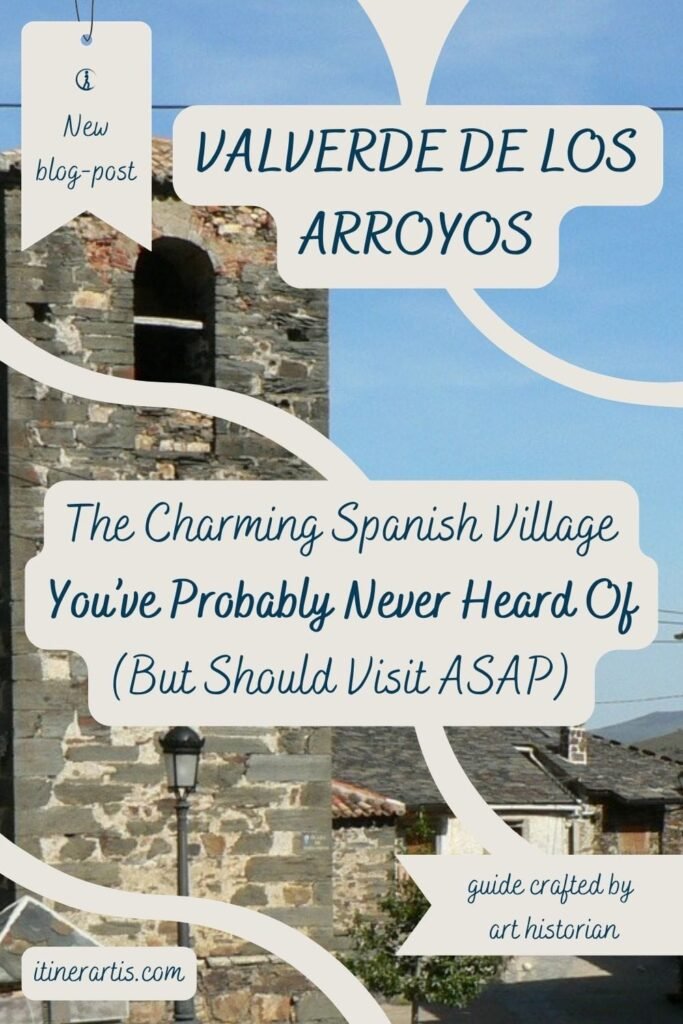
- Where Is Valverde de los Arroyos & How to Get There?
- Why Is Valverde de los Arroyos So Special?
- A Step Back in Time: The Living History of Valverde de los Arroyos
- What to Do in Valverde de los Arroyos: Must-See Highlights
- Plaza de María Cristina: The Beating Heart of the Village
- Church of San Ildefonso: A Testament to Faith and Time
- The Ethnographic Museum: A Window into Valverde de los Arroyos’ Past
- Chorreras de Despeñalagua: Valverde de los Arroyos’ Hidden Cascade
- Hermitage of the Virgen de Gracia: A Quiet Refuge in the Mountains
- Authentic Activities: Experience Valverde de los Arroyos Like a Local
- When’s the Perfect Time to Visit Valverde de los Arroyos?
- Ideal Length of Stay: How Long Should You Spend in Valverde de los Arroyos?
- Valverde de los Arroyos—A Timeless Escape Waiting to Be Discovered
“Wherever you go becomes a part of you somehow.”
— Anita Desai

Where Is Valverde de los Arroyos & How to Get There?
Tucked away in the Sierra Norte of Guadalajara, Valverde de los Arroyos is one of Spain’s most enchanting hidden villages. Nestled on the western slopes of Pico Ocejón, a 2,048-meter (6,719-foot) peak, this remote gem feels untouched by time. Its very name—Valverde de los Arroyos—hints at the crystal-clear streams that flow through the valley, fed by snowmelt from the surrounding mountains.
At 1,250 meters (4,101 feet) above sea level, the village experiences dramatic seasonal changes. Winter cloaks its slate rooftops in snow, turning it into a postcard-perfect retreat. In spring, wildflowers burst into bloom, carpeting the meadows in vibrant colors. Summer brings deep green forests and cool mountain breezes, offering an escape from Spain’s sweltering heat. By autumn, the surrounding woodlands glow in hues of gold and crimson, making it an idyllic time to visit.
How to Get to Valverde de los Arroyos
Despite its secluded feel, Valverde de los Arroyos is surprisingly accessible. It lies just 130 kilometers (ca. 81 miles) from Madrid and 75 kilometers (ca. 47 miles) from Guadalajara, making it a perfect weekend escape. The scenic two-hour drive from Madrid takes you through Castilla’s rolling plains before reaching Tamajón, the gateway to the Pueblos Negros. From there, the GU-211 road winds through oak forests and striking rock formations, leading to the village, hidden like a forgotten treasure in the hills.
Public transport is scarce, with only occasional bus services from Guadalajara. Driving is the best option, and upon arrival, a designated parking area welcomes visitors just outside the village. From there, Valverde is best explored on foot, allowing you to wander its cobbled lanes and soak in its timeless charm.
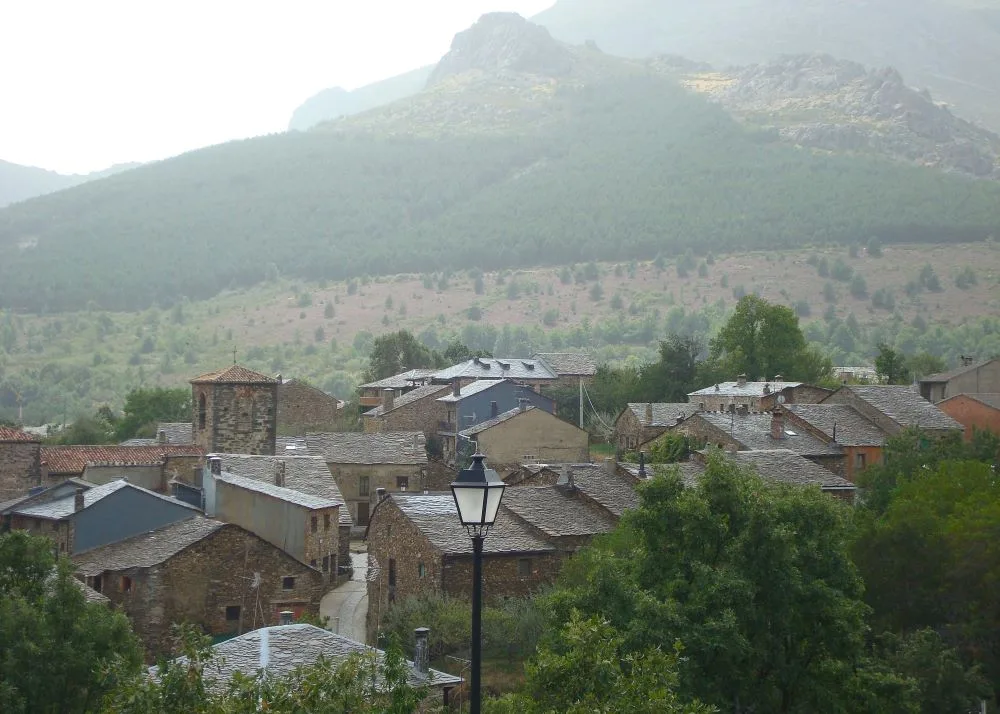
Why Is Valverde de los Arroyos So Special?
Some places demand attention; others whisper their beauty to those who take the time to listen. Valverde de los Arroyos is one of the latter. Hidden in the Sierra Norte de Guadalajara, this village feels as though it was shaped by the land itself—black slate houses blending seamlessly with the earth, narrow streets meandering like forgotten footpaths, and mountains standing as silent guardians.
The first thing you’ll notice is its arquitectura negra. The dark slate and quartzite walls, flecked with gold, catch the sunlight, making the houses seem both ancient and alive. In summer, they contrast against the deep green of the meadows; in winter, they disappear under a layer of silent snow. Walk through the village, and you’ll find stone staircases that lead to nowhere, wooden doors worn smooth by generations of hands, and geranium-filled balconies that spill color over the dark façades. Nothing here feels staged—only preserved, as if time itself had decided to linger a little longer.
But the true magic of Valverde lies beyond its architecture. The village is cradled in a natural amphitheater, where oak and chestnut forests shift with the seasons, and wildflowers burst into life along bubbling streams. Just beyond the last houses, the Chorreras de Despeñalagua waterfall tumbles down the mountainside, sending a fine mist into the air. At night, the absence of artificial light reveals a sky so dense with stars it feels like the universe is leaning in. Here, the world moves slower. Footsteps echo on stone. The wind carries the scent of woodsmoke. And for a little while, nothing exists beyond this quiet mountain retreat.

A Step Back in Time: The Living History of Valverde de los Arroyos
High in the Sierra Norte of Guadalajara, where mountain winds weave through slate-roofed homes, Valverde de los Arroyos carries the weight of centuries. Its exact origins remain uncertain, but history whispers through its cobbled streets. Some believe its foundations were laid in the Middle Ages, perhaps even earlier. Remote and self-sufficient, the village preserved traditions long-lost elsewhere—some of which hint at pre-Christian fertility rituals. Among them, the Corpus Christi festival stands out: dancers in meticulously embroidered white garments perform ancient steps, their movements eerily reminiscent of Iberian rites from a distant past.
By the 17th and 18th centuries, Valverde had become a small but thriving rural community. Families relied on livestock, grain farming, and weaving, their homes built to withstand the region’s harsh winters and rugged terrain. An 1849 account described a mountain village of 60 stone houses, where survival meant resilience. As Spain modernized, many left in search of opportunity. So, by the 1970s, only a handful of families remained, though those who stayed kept Valverde de los Arroyos alive. In 1916, to distinguish it from other villages named Valverde, it was given a name that reflected its landscape—the Valley of Streams.
Local legend, however, tells a more poetic tale. It is said that on the last day of Creation, as the light faded, God formed the black villages of Guadalajara in twilight, giving them their dark, otherworldly beauty. Whether myth or memory, the slate homes, enduring customs, and quiet strength of Valverde de los Arroyos remain unchanged.
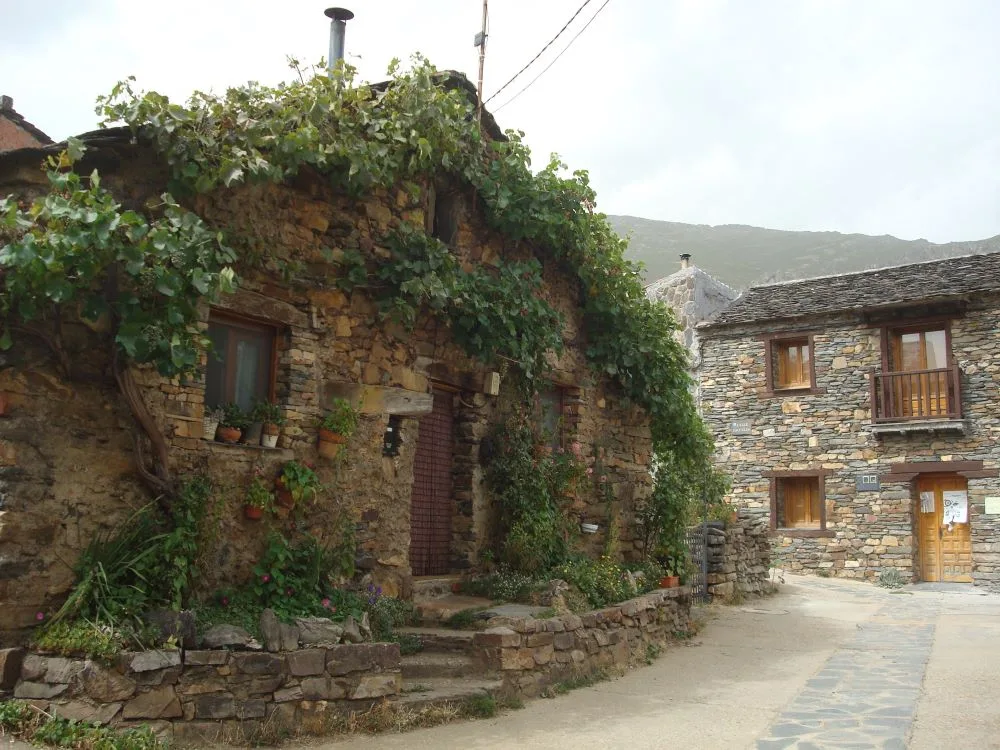
What to Do in Valverde de los Arroyos: Must-See Highlights
Though small, Valverde de los Arroyos is filled with unforgettable sights that blend natural beauty with historic charm. Every step through its slate-paved streets reveals a postcard-perfect scene, where time slows and tradition lingers.
Plaza de María Cristina: The Beating Heart of the Village
At the heart of Valverde de los Arroyos lies its picturesque main square, a broad, flagstone-paved plaza framed by centuries-old slate cottages. There’s no imposing monument here—just an elegant harmony of stone, wood, and flowers. In the center, an old stone fountain murmurs, its water sourced from the pure mountain streams. Wooden balconies overflow with geraniums, adding bursts of color to the dark slate facades. This is where life unfolds: elders chatting on benches, visitors sipping local wine on tavern terraces, and the occasional shepherd passing through with his flock.
Overlooking the square, the Parish Church of San Ildefonso is a testament to the village’s devotion. Built with the same slate that defines Valverde, its simplicity is its charm. As daylight fades, the square transforms. Lanterns flicker, and the sound of footsteps on stone echoes under a sky ablaze with stars.
To truly experience Valverde de los Arroyos, sit on a bench and take it all in. Feel the roughness of the slate beneath your fingers. Listen to the rhythmic splash of the fountain. Breathe in the scent of wood smoke curling from chimneys on a crisp autumn evening. This is rural Spain at its most enchanting, a place where every detail invites you to linger just a little longer.
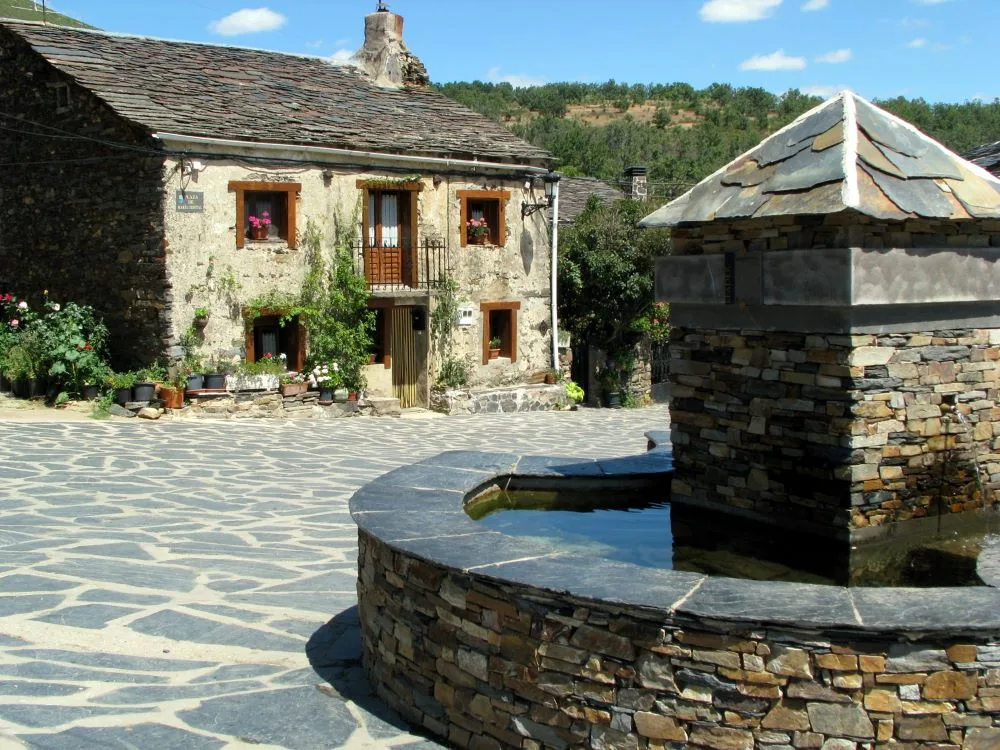
Church of San Ildefonso: A Testament to Faith and Time
Standing at the edge of Plaza de María Cristina, the Church of San Ildefonso is a quiet yet striking presence in Valverde de los Arroyos. Built in the 19th century, it embodies the village’s deep-rooted traditions. Its stout slate bell tower, capped with weathered timber, rises modestly above the rooftops. On winter mornings, when frost clings to its dark stones, the church takes on a storybook charm—simple, steadfast, and serene.
Step closer and admire the precision of its stone-masonry, a testament to the craftsmanship of past generations. The wooden portico, a rustic yet elegant feature, offers shelter to those who pause before entering. Inside, if the doors are open, an unexpected treasure awaits—a 16th-century silver processional cross, an exquisite relic of Renaissance artistry. Its intricate engravings hint at a time when faith and fine craftsmanship intertwined, even in remote villages.
Even without stepping inside, the Church of San Ildefonso leaves an impression. Its silhouette against the Sierra Norte mountains evokes the resilience of Valverde de los Arroyos itself—a village that has withstood the passage of time, its traditions intact. Visit on a Sunday or festival day, and you may hear the bells ring across the valley, their echoes drifting through the oak forests.

The Ethnographic Museum: A Window into Valverde de los Arroyos’ Past
Tucked away on a quiet street near Plaza de María Cristina, the Ethnographic Museum of Valverde de los Arroyos offers an intimate glimpse into the village’s past. Small yet rich in character, it is a place where history isn’t just displayed—it lingers in every handcrafted tool, every faded photograph, every carefully preserved relic of daily life.
Housed in a traditional slate-and-stone building, the museum transports visitors to a time when Valverde thrived as a self-sufficient rural community. Inside, looms and wool-spinning equipment hint at its once-flourishing textile industry, where villagers wove their own embroidered garments. Farming tools, kitchen utensils, and weathered black-and-white photographs reveal the rhythms of mountain life—long winters, harvest celebrations, and the simple ingenuity required to survive in this remote enclave.
A highlight of the collection is the Corpus Christi festival exhibit, where delicate lace trimmings and colorful ribbons showcase the costumes worn by dancers in one of Spain’s oldest religious traditions. The museum may be small, but its stories are vast. Listen to the caretaker’s anecdotes, and you might hear about wedding processions through the cobbled streets or how villagers once traveled by mule to distant markets.
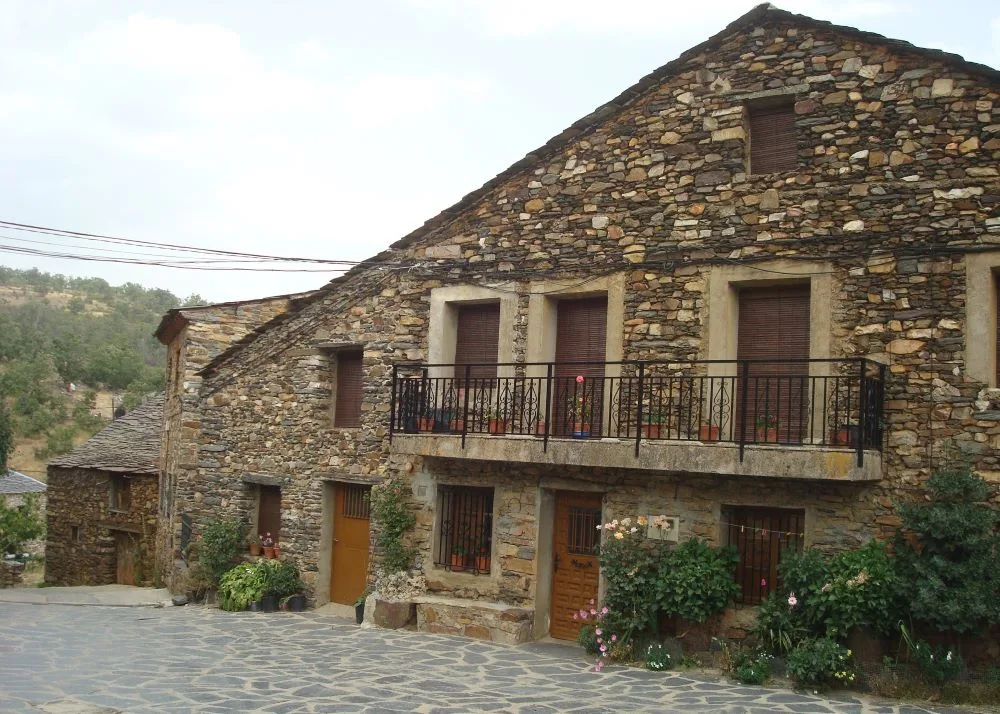
Chorreras de Despeñalagua: Valverde de los Arroyos’ Hidden Cascade
Tucked beyond the slate rooftops of Valverde de los Arroyos, nestled in a valley of chestnut forests and wildflower meadows, lies one of the most breathtaking natural wonders in the region—Chorreras de Despeñalagua. This multi-tiered cascade plunges over dark rock ledges, tumbling 120 meters (394 feet) into moss-lined pools. More than just a waterfall, it is a place where time slows, and nature takes center stage.
Reaching Chorreras de Despeñalagua is part of the experience. The 30 to 40-minute hike begins on a gentle, well-marked trail that winds through lush greenery and clear brooks. As you walk, the scent of damp earth and mountain herbs fills the air. Step by step, the distant roar of water grows louder, a natural crescendo that builds anticipation. Then, as if scripted, the forest parts to reveal La Chorrera—an elegant silver ribbon cascading down the cliffside, mist swirling in the sunlight.
Each season transforms the falls. In spring, melting snow feeds the cascade, turning it into a thundering rush of water. By autumn, the forest glows in burnt orange and crimson, framing the waterfall in a painter’s dream of color. Winter adds an ethereal touch, with ice formations sculpting the rocks into frozen artistry.
For the best experience, pack a picnic and settle onto the smooth stones near the base. Feel the cool mist kiss your skin, listen to the echoing rhythm of falling water, and let the sheer grandeur of the landscape remind you why places like Valverde de los Arroyos remain unforgettable.
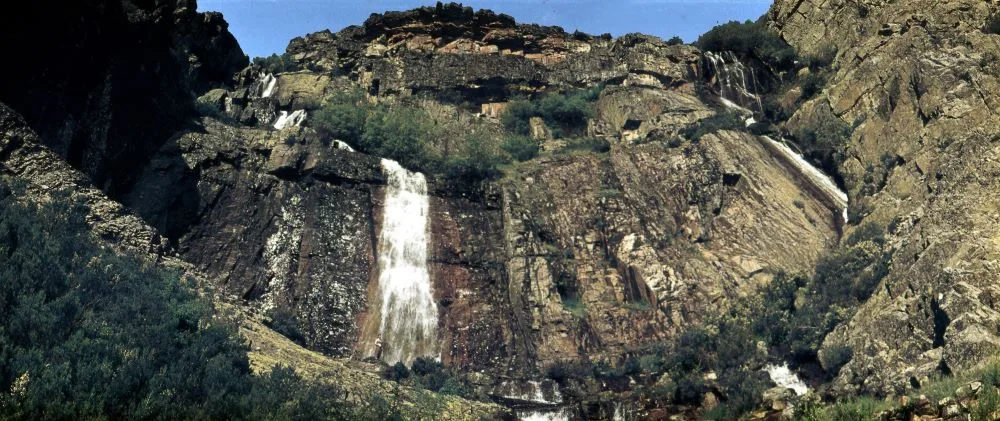
Hermitage of the Virgen de Gracia: A Quiet Refuge in the Mountains
Just beyond the last slate-roofed houses of Valverde de los Arroyos, a narrow path winds toward a small, timeworn chapel—the Hermitage of the Virgen de Gracia. Modest in size yet profound in presence, it sits in solitude, surrounded by the whisper of the wind and the quiet embrace of the mountains. Here, time slows, and the world outside fades into stillness.
If the doors are open, step inside. A humble stone altar stands at the heart of the chapel, adorned with flickering candles left by villagers—tiny flames carrying silent prayers. Though simple, the hermitage remains deeply tied to local traditions. During festivals, processions weave through the village, guiding worshippers to this sacred space. In those moments, Valverde de los Arroyos pulses with the rhythm of its past, as faith and history intertwine beneath the mountain sky.
For the most poignant experience, arrive in the late afternoon, when the golden light bathes the chapel’s stone walls. As the sun sinks behind Pico Ocejón, shadows stretch across the fields, turning the landscape into a canvas of deep oranges and soft purples. Whether you come for spiritual reflection, historical curiosity, or simple solitude, this hermitage offers something rare—a silence that lingers, a peace that stays with you long after you leave.
Like the plaza, the church, the museum, and the waterfall, the hermitage is not a spectacle, but a piece of Valverde’s soul. Here, beauty is not kept behind ticket booths or grand facades—it is woven into the landscape, into tradition, into the way sunlight falls on stone.
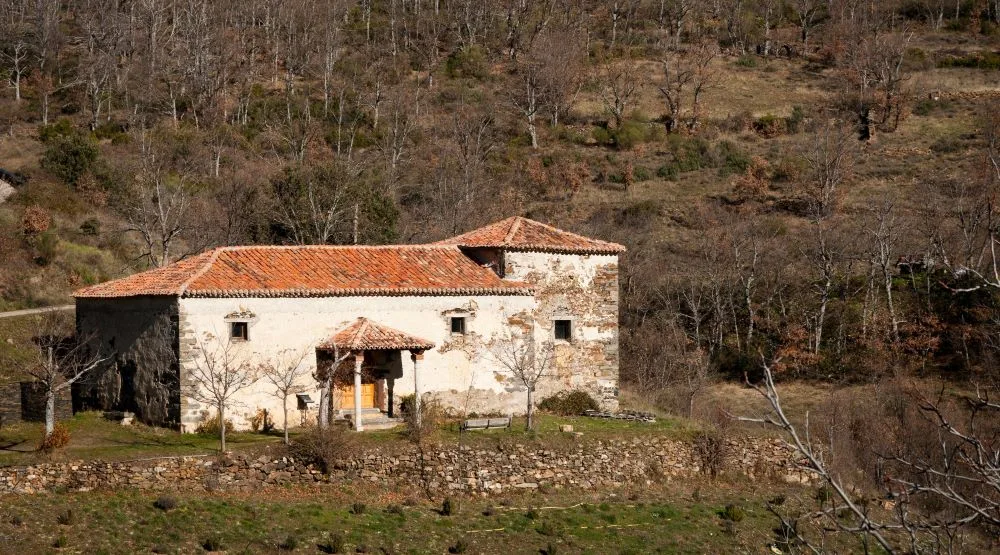
Authentic Activities: Experience Valverde de los Arroyos Like a Local
To truly experience Valverde de los Arroyos, slow down and embrace the village’s rhythm. Here, life moves at a different pace—one that encourages wandering, observing, and immersing yourself in tradition. Whether hiking to waterfalls, capturing the pueblos negros architecture through a lens, or sharing stories with locals, each moment adds depth to your visit.
Hike to Chorreras de Despeñalagua and Beyond
The Chorreras de Despeñalagua waterfall is a must-see, but the journey is just as rewarding. The 40-minute trail winds through chestnut groves, wildflower meadows, and bubbling streams, gradually revealing the cascading falls. For those craving adventure, continuing upward rewards hikers with panoramic views over the valley. Meanwhile, the most ambitious can tackle Pico Ocejón, a three-hour ascent leading to breathtaking views of the Sierra Norte.
Capture the Village Through Photography
Every alley, balcony, and slate façade in Valverde de los Arroyos is a photographer’s dream. The Golden hour casts long shadows and rich textures, turning even the simplest stone wall into art. Don’t miss the hand-carved plaques in the square or the occasional dancers’ mural, both offering glimpses into village traditions.

Join in Traditional Festivities
If you visit in early summer, the Octava del Corpus festival is an unmissable spectacle. Locals, dressed in elaborate white costumes, perform ritual dances passed down for generations. Meanwhile, the botarga, a mischievous masked figure, entertains the crowd. Beyond Corpus Christi, seasonal fiestas bring the village to life with music, bonfires, and communal feasts.
Taste the Flavors of the Sierra Norte
Despite its size, Valverde de los Arroyos has a rich culinary identity. Warm up with migas (garlicky breadcrumbs) or caldereta, a slow-cooked lamb stew. In autumn, wild mushrooms take center stage, adding earthy depth to rustic dishes. For a sweet touch, sample local honey, prized for its wildflower and chestnut varieties.
Discover Local Craftsmanship
If you’re lucky, you might meet a villager weaving wool, carving wood, or repairing a slate roof. Occasionally, summer workshops offer hands-on experiences, from cheese-making to natural dyeing techniques.
But, above all, let Valverde de los Arroyos guide you into its slower rhythm. Sit by the stone fountain and watch swallows dart through the sky. Walk to the green pastures above town at dusk, watching the lights flicker on in the cottages below. Perhaps help a farmer herd his sheep for a few minutes, or join locals in the village tavern for an evening of stories and laughter.

When’s the Perfect Time to Visit Valverde de los Arroyos?
Each season transforms Valverde de los Arroyos, offering a different kind of magic. Whether you seek blooming landscapes, vibrant festivals, fiery autumns, or winter solitude, the best time to visit depends on what kind of experience you’re after.
Spring (March to May): Nature in Full Bloom
As winter recedes, Valverde de los Arroyos bursts to life. Wildflowers paint the meadows in vivid colors, while fruit trees sprinkle the village with white and pink blossoms. Meanwhile, the Despeñalagua waterfalls reach their most powerful state, fed by melting snow. Days are mild and sunny, perfect for hiking, though nights can still be chilly. Spring is ideal for photographers, nature lovers, and those seeking a tranquil escape before summer arrives.
Summer (June to August): Sun, Festivals, and Starry Nights
Long, warm days bring a lively energy to the village. In June, the Corpus Christi festival fills the square with ancient dances, colorful costumes, and a sense of community. Hiking trails are dry and inviting, with Pico Ocejón offering spectacular panoramic views. By evening, cool mountain breezes make outdoor dining a delight. Although summer attracts more visitors, Valverde de los Arroyos remains peaceful, with its charm intact.

Autumn (September to November): The Village at Its Most Enchanting
For many, autumn is the most magical time to visit. Forests of oak and chestnut trees turn golden and crimson, creating breathtaking scenery. Meanwhile, villagers forage for chestnuts and wild mushrooms, adding seasonal flavors to local cuisine. Fewer tourists mean you’ll have the trails and plaza mostly to yourself. If you love solitude, crisp air, and spectacular landscapes, autumn is unbeatable.
Winter (December to February): A Snowy Mountain Retreat
During winter, Valverde de los Arroyos transforms into a fairytale village. Snow often dusts the rooftops, while the waterfall partially freezes, forming delicate ice sculptures. Nights are cold, but crackling fireplaces and hearty stews provide warmth. Though some businesses have reduced hours, those who visit are rewarded with tranquility and a winter wonderland untouched by crowds.
The Best Time? Autumn, But Every Season Has Its Charm
For color, solitude, and ideal hiking conditions, autumn is the standout choice. However, Valverde de los Arroyos is captivating year-round, whether under cherry blossoms, sunlit stone houses, golden forests, or snow-covered peaks. If you prefer an intimate experience, consider visiting on a weekday or during the shoulder seasons—when the village feels like yours alone.

Ideal Length of Stay: How Long Should You Spend in Valverde de los Arroyos?
While it’s possible to visit Valverde de los Arroyos in a day, rushing through would mean missing its quiet magic. To truly immerse yourself in the village’s rhythms, two to three days offer the perfect balance of exploration, relaxation, and cultural discovery.
Day 1: Arriving and Settling into Village Life
After arriving around midday, check into a charming slate-roofed cottage or a family-run inn. Then, take a leisurely stroll through the main square, where time slows to the sound of a trickling stone fountain. Enjoy a coffee at a terrace while observing village life unfold. Later, wander through narrow streets like Calle Real and visit the Ethnographic Museum for a glimpse into Valverde’s past. As sunset paints Pico Ocejón in pink hues, walk uphill to capture the view. In the evening, savor a traditional Castilian dinner of roasted lamb or garlic soup, then marvel at a sky ablaze with stars.
Day 2: Nature, Adventure, and Local Encounters
Begin with a hike to Chorreras de Despeñalagua, where the mist of the waterfall cools your skin. If you crave more adventure, ascend towards Pico Ocejón or explore hidden trails leading to panoramic viewpoints. After lunch, embrace a local experience—perhaps visiting another black village, learning to milk a goat, or chatting with artisans. In the evening, relax by a fireplace with a glass of Spanish wine.
Day 3 (Optional): A Deeper Connection
For a slower pace, spend your third day wandering. Visit nearby Pueblos Negros, forage for chestnuts in autumn, or simply linger over a long lunch. By the end of your stay, you’ll have felt Valverde’s timeless embrace—one that lingers long after you leave.

Valverde de los Arroyos—A Timeless Escape Waiting to Be Discovered
As you leave Valverde de los Arroyos, perhaps in the early morning mist or under a sky ablaze with sunset hues, you might glance back one last time. The slate rooftops, the winding stone paths, the ever-present murmur of water—these are not just sights but sensations that linger, whispering an invitation to return. Remember the question we posed at the beginning? This village has answered it with quiet charm, wrapping you in its timeless embrace, if only for a fleeting moment. Some places impress you; others stay with you. Valverde is the latter.
Yet, even the most secret places don’t stay hidden forever. Valverde de los Arroyos is still an undiscovered gem, but word is slowly spreading. It has already earned its place among Spain’s most beautiful villages, a testament to its enduring allure. However, the true magic of visiting now lies in experiencing it while its charm remains untouched. Imagine wandering its quiet lanes, hiking its serene trails, or sharing a simple meal in the square, feeling as though time itself has paused just for you. Whether you seek a spring retreat filled with wildflowers, an autumn escape framed by golden forests, or a festive summer celebration, this village welcomes those who crave authenticity and connection.

So why wait? Valverde de los Arroyos is waiting for you. Plan your journey, chase its waterfalls, hike its peaks, and immerse yourself in its traditions. Here, among the pueblos negros, Spain’s history is still alive, woven into each slate stone and every kind smile from a local. Pack your bags, follow the winding road, and let Valverde write its story upon your heart. Safe travels, and ¡hasta pronto!


